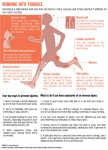Editor’s Note: Over the next 22 weeks, Bruin reporter Katie Shepherd will be training for the Asics L.A. Marathon and writing a weekly column chronicling her experiences along the way. She’ll be reporting on the science and health aspects of endurance training as well as featuring students and L.A. residents who are taking on similar races this year.
Two miles into my training for the Asics L.A. Marathon and I already had my first injury. A large, rubbery blister spread painfully across the ball of my right foot.
But as far as running injuries go, a blister is the least of my concerns.
Overuse and stress injuries can sideline any athlete, especially athletes participating in intense, high-impact exercises like long-distance running.
“I see a cluster of people coming in (for treatment) around the L.A. Marathon because they are doing too much, too fast,” said Dr. Dena Florczyk, a physician at the Arthur Ashe Student Health and Wellness Center who specializes in sports medicine.
It takes about six months to safely train for a marathon if a person hasn’t been especially active before starting, she said.
Increasing running distances too quickly can lead to shin splints, stress fractures, muscle pulls, runner’s knee and more. The common denominator in these overuse injuries is taking on too much activity, too quickly.
“The rule of thumb is no jumps in distance of more than 10 percent per week,” Florczyk said. “That’s the safe way for you to increase so your body can adapt to the activity, which is a high-impact activity.”
Keeping a slow-and-steady attitude about training is important to building a healthy body that will be able – eventually – to run 26.2 miles.
But I don’t have the best track history of taking it slow.
About four years ago, I had my first encounter with shin splints. I was playing high school field hockey and club soccer for two months, and then I pushed myself through soccer tryouts at my high school as the sports season was transitioning.
Doing too much at once spelled disaster for my soccer season, and eventually my lower legs hurt so much that I couldn’t even jog and could barely walk. I had to spend much of the winter of my junior year on the bench instead of the field.
Luckily, my coaches pulled me off the field soon enough. Shin splints, gone untreated, could lead to a more serious injury like a stress fracture – a small, incomplete break in a bone.
I’m taking on an equally strenuous activity now, but this time I’m going into my training with stress injuries in mind.
Florczyk said there are four strategies that can help prevent overuse injuries associated with running: keep a strong core, maintain flexibility, buy supportive footwear every six months and increase training gradually.
And if you do start feeling pain in your shins, knees or hips, take a day or two off from training, she added. If the pain sticks around even when you aren’t running, visit a doctor.
During the break from running, physical activity and fitness can be maintained through low-impact activities like cycling, swimming and aqua running – the whimsical term for running in a pool.
When the pain subsides, return to running, but be careful to increase distances slowly, Florczyk said.
I’m planning to do a few things to prevent injuries based on Florczyk’s advice.
First, I’m enrolling in my first yoga class to help keep my muscles flexible.
I’m buying a foam roller to facilitate stretching after my runs – you should only stretch after a run because research indicates stretching before a workout can reduce your power.
And I’m going to the John Wooden Center at least once a week to work on strengthening my core muscles – those around the abdomen, hips and glutes – to prevent runner’s knee and hip pain. Doing strength training with free weights, like squats and lunges, and using equipment such as adductor/abductor machines will help stave off injuries.
But most importantly, I’m taking my sweet time training so that I can gradually increase my running distances week by week over six months.
If you have questions regarding endurance training, running or marathons, email Shepherd at kshepherd@media.ucla.edu.
